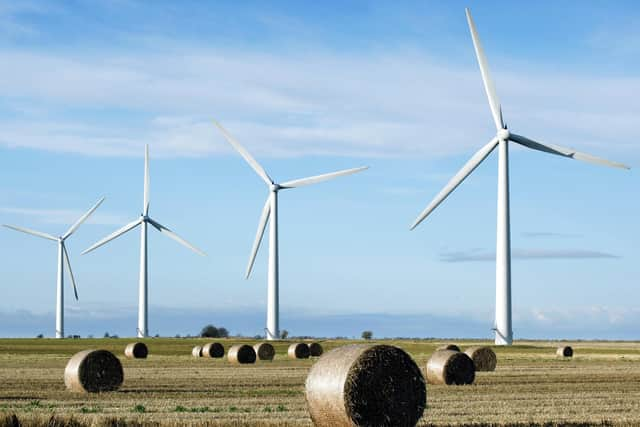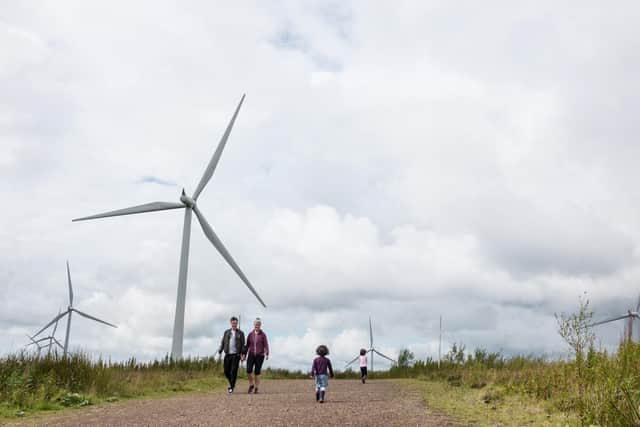Onshore wind companies call for ‘ban’ on new turbines to be dropped
Ministers are planning to re-write a rule, which states turbines can only be built on pre-designated land in England, and allow developers to set up more in areas where they can gain “local support”.
But James Robottom, from Renewable UK, which represents onshore wind companies, said the “ambiguous” proposal is “not really going to make any difference”.
Advertisement
Hide AdAdvertisement
Hide AdMr Robottom, who is Head of Onshore Wind, said companies feel like they “can’t take the risk” and begin investing in new projects that could be easily blocked by local objectors.


“Even if onshore wind had not been singled out in planning, it would still be risky and challenging,” he added.
“We don't believe that onshore needs to be or should be treated differently. It should be treated like any other infrastructure in England throughout the planning process."
Richard Dunkley, Managing Director of Banks Renewables, said the company currently owns and operates four onshore wind farms in Yorkshire, but it has not attempted to set up any new turbines in England since the “short-sighted ban” was introduced eight years ago.
Advertisement
Hide AdAdvertisement
Hide Ad“The UK’s transition to a low cost, low carbon and energy secure environment has been unnecessarily delayed,” he said.


“Consumers and Government are now facing the consequences of this decade’s delay, and of the UK not taking responsibility for being self-sufficient for our own energy, in higher electricity bills driven by high gas prices.”
Under current planning rules, introduced by David Cameron in 2015, companies can only apply to build onshore wind turbines in England on land specifically identified for these developments in a council’s local plan.
More than 430 turbines were permitted to be built on 108 sites in England over a four-year period before the rules were tightened. Just 16 were built on seven sites over the following four years.
Advertisement
Hide AdAdvertisement
Hide AdA Government poll conducted last year found almost eight out of 10 people (78 per cent) support onshore wind, but less than half (43 per cent) would be happy for turbines to be built in their local area.
Back in 2015, the so-called ban was welcomed by protest groups, who claimed the turbines were spoiling views in rural areas, making too much noise and harming birds.
Sir Greg Knight is the Conservative MP for East Yorkshire, which is home to hundreds of onshore turbines and overlooks two of the world’s largest offshore wind farms – Hornsea 2 and Dogger Bank Wind Farm.
“The view is taken here that we've got enough, particularly as we are an area of outstanding natural beauty,” he said.
Advertisement
Hide AdAdvertisement
Hide Ad“I think some people who are struggling with the energy crisis may change their view, but a lot of people will remain opposed to them.
“One of the benefits of being an island is that we don't need to put these wind farms onshore, we can put them out at sea where no one objects.”
Mr Knight said he would welcome changes to the planning rules if local communities were given “a genuine veto”.
"What has been unacceptable in the past is where local communities said they don't want one, but they’ve been lumbered with one anyway because some faceless, nameless planning inspector who lives miles away has overturned the council’s planning refusal,” he added.
Advertisement
Hide AdAdvertisement
Hide AdProfessor Dan Gladwin, an electrical engineering specialist from the University of Sheffield, said onshore wind is one of the cheapest sources of renewable energy, after solar, and it is quicker and cheaper to set up turbines on land.
But he also said that since the planning rules were tightened, it has been “challenging” to build the larger turbines, which can generate more power but are also “much quieter” and fitted with technology designed to protect birds.
Wind farms generated a record 26.8 per cent of the UK’s electricity last year and on November 30 they generated over 20 gigawatts for the first time, which was enough to meet half the county’s demands.
However, Professor Gladwin said setting up thousands of new turbines across the country would not solve the UK’s energy issues overnight.
Advertisement
Hide AdAdvertisement
Hide AdThe wind is not seen as the most reliable source of energy, as it does not always blow, and most of the National Grid’s large-scale batteries can only store up to 90 minutes of power, so it cannot be saved for another day.
Energy generators must also wait in a long queue before they can get connected to the grid.
“We need to do a lot more to incentivise investment in storage," said Professor Gladwin.
"With short-term shortage, we're getting there, and with long-term storage we do have some technologies, but they need to be developed at a very large scale.”
Advertisement
Hide AdAdvertisement
Hide AdHe has also pointed out that an influx of onshore wind farms is unlikely to lead to a significant reduction in energy bills under the current system, as gas producers dictate the price of energy.
When suppliers buy energy on the international wholesale market, they need gas to ensure they can meet demand, even when the bulk of electricity is generated by cheaper renewable sources.
Gas companies charge the highest prices, because they have the highest costs, and this allows other energy generators to charge similar prices.
The Government is being urged to follow in the footsteps of the European Commission, which is devising a new system that will decouple gas and electricity prices.